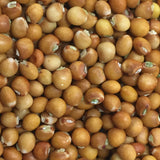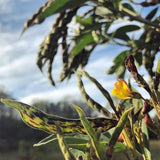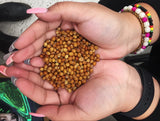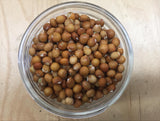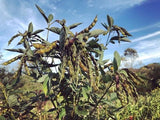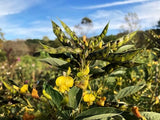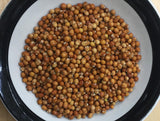Northern Adapted Pigeon Peas (Gandules)
Cajanus cajan
From our friends at East New York Farms!:
Pigeon peas, called "Gandules" in Spanish and "Gungo peas" in Jamaica, are a staple food in the Caribbean community in East New York. In our neighborhood, gardeners and other community folks have shared with us that they normally harvest the peas at the shelling stage and cook them with rice and coconut milk, or add the peas to hearty soups and stews which may include some combination of pumpkin, cooked greens like callaloo or malabar spinach, dumplings, and fresh coconut among other ingredients. Some folks even use the leaves of the plant to make tea! In the tropics, they are typically harvested right around the holiday season, and multiple folks have told us some variation of, "it wouldn't be Christmas without gungo peas!".
They have a high nutritional value and are easy to grow, being drought resistant and not requiring pest control. They can be grown on marginal land. Pigeon peas are grown in tropical and sub-tropical areas throughout the world. Although India is the top producer (where it's called "toor dal" or "arhar dal"), they are also grown in Africa, Southeast Asia, and Central America. In the tropics, the plant is a short-lived perennial.
Because pigeon peas grown in the tropics require long nights to trigger flowering, they typically do not mature in our northern latitude/climate until late in the season and cannot set seed before frost. Dr. Sharad Phatak, of the University of Georgia-Tifton, developed pigeon pea varieties that are not as day length sensitive and can begin flowering and setting seed earlier in the season. This variety is one of the two varieties Dr. Phatak gave to East New York Farms via Mohammad Faroze, a former staff at Cornell Cooperative Extension. We've grown these seeds out for several years at East New York Farms with good luck.
Days to maturity: 120
Seeds per pack: 15
Germination rate: 84% on 01/17/2025
Planting / harvesting notes
Plants can be direct sown around or shortly after last frost (end of May or early June in Brooklyn) or sown in the greenhouse 4-6 weeks earlier and transplanted after last frost. We use 1-2' spacing in row, in rows that are 2' apart. Plants grow slowly but eventually reach around 4' tall! They form a main stem that is woody and sturdy, not requiring trellising or support. In Brooklyn, our plants began flowering in late summer and we harvested pods incrementally as they turned brown and dry throughout September and October. If you want to harvest for fresh eating, you can harvest the pods when they are green and plump, though you may want to let some early pods mature for seeds to select for early maturity.
Seed keeping notes
Harvest seeds when pods have dried and turned crispy brown. Watch for caterpillars that eat through the seed pods, consuming the seeds. When the pods are fully dried, shell the seeds and allow them to dry further in a ventilated, dry, dark room.








